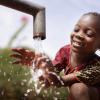
A new tool to assess water security can help nations plan for a challenging future.
Earth’s flow of fresh water is under threat. While the thirst of human society grows, climate change and the depletion of nature are combining to spoil the supply, leading to water scarcity, droughts, floods, and pollution. Each country faces a different balance of risks, so a consortium led by IIASA has developed a new method to assess national water security and identify solutions.
“Our objective is to shift from traditional development approaches, which take water security for granted, and instead emphasize the need to manage the dynamic future of water,” says project leader Taher Kahil, head of the Water Security Research Group at IIASA. “Comprehensive assessments can identify where water security is a concern, guide infrastructure investment and institutional reform, and inform high-level political and public dialogue on the nature and seriousness of water issues and the actions needed to address them.”
In the past, relatively few national assessments have been made, and they have usually required a long and involved process involving field measurements, experiments, and modeling.
“The idea we are developing is to do rapid assessment, based mainly on available data, which is often not properly exploited,” says Kahil. “This cuts the timescale from years to months, and reduces the amount of resources needed. It doesn’t cost millions of dollars”.
The project was sponsored by the World Bank. The Bank already had a conceptual framework that lays out several dimensions for assessing water security, including a country’s physical endowment of water, and the water infrastructure and institutions in place. They wanted IIASA to build on this and find a way to apply it using a systems-based approach, which has now resulted in the One-Water Methodology.
An essential early stage is to identify indicators: numbers available in existing data that give a reliable measure of each security dimension. Looking at the Europe and Central Asia region, the team identified 86 such indicators ranging from total water resources per capita, through sewer coverage and water storage capacity, to outcomes such as flood deaths and wetland loss.
The next step is using these indicators to diagnose the existing situation in a country. This will allow researchers to project likely future changes based on any existing modeling work along with new qualitative scenarios developed with local stakeholders. The results will be combined to form a national narrative of current and future challenges, risks, and opportunities to water security. This insight can then be used to identify potential actions, analyze their effectiveness, and so devise action plans.
Now that they have laid out this methodology, the team will apply it to five countries: Albania, Bosnia, Croatia, Montenegro, and Serbia. They will see how it works in practice, and refine it based on what they learn. The hope is that the One-Water Methodology will become the standard way to assess water security. If its rapid assessment points to a serious issue that needs to be solved, a country could then use more detailed modeling and other research to dive deeper.
